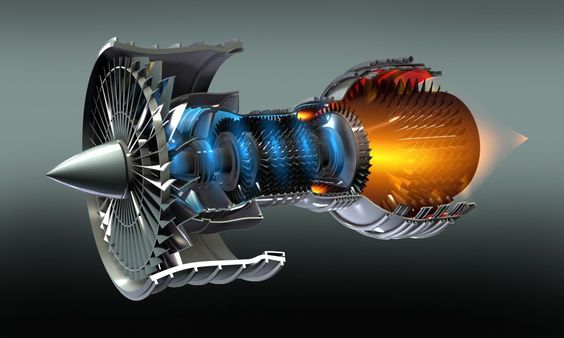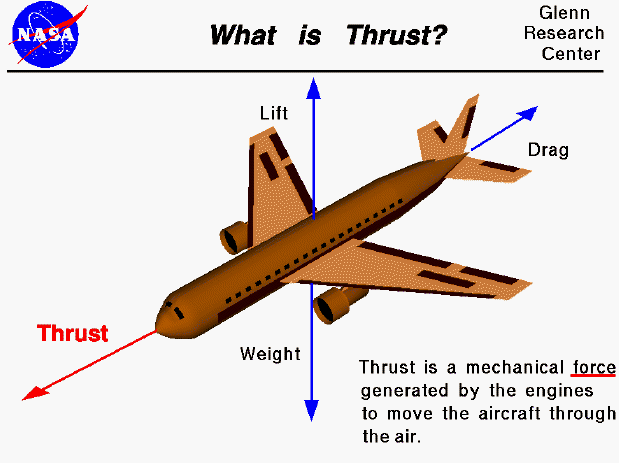|
This article is about to give a brief idea about propulsion and different kinds propulsive devices. Here we just cover the very basics of different propulsion. A detailed article will publish sometime later. What is propulsion and propulsion system? Propulsion means to push forward or drive an object forward. A propulsion system is a machine that produces thrust to push an object forward. On airplanes, thrust is usually generated through some application of Newton's third law of action and reaction. A gas, or working fluid, is accelerated by the engine, and the reaction to this acceleration produces a force on the engine. There are hundreds of different kinds of propulsion; here we only considering some of the Rocket propulsion, air breathing propulsion & electric propulsion. Why are the different types of engines? If we think about Newton's first law of motion, we realize that an airplane propulsion system must serve two purposes. First, the thrust from the propulsion system must balance the drag of the airplane when the airplane is cruising. And second, the thrust from the propulsion system must exceed the drag of the airplane for the airplane to accelerate. In fact, the greater the difference between the thrust and the drag, called the excess thrust, the faster the airplane will accelerate. Some aircraft, like airliners and cargo planes, spend most of their life in a cruise condition. For these airplanes, excess thrust is not as important as high engine efficiency and low fuel usage. Since thrust depends on both the amount of gas moved and the velocity, we can generate high thrust by accelerating a large mass of gas by a small amount, or by accelerating a small mass of gas by a large amount. Because of the aerodynamic efficiency of propellers and fans, it is more fuel efficient to accelerate a large mass by a small amount. That is why we find high bypass fans and turboprops on cargo planes and airliners What is thrust? Thrust is the force which moves the vehicle. Thrust is generated by the propulsion system. Different propulsion systems develop thrust in different ways, but all thrust is generated through some application of Newton's third law of motion How is thrust generated? Thrust is a mechanical force which is generated through the reaction of accelerating a mass of gas, as explained by Newton's third law of motion. A gas or working fluid is accelerated to the rear and the engine and vehicle are accelerated in the opposite direction. To accelerate the gas, we need some kind of propulsion system. A general derivation of the thrust equation shows that the amount of thrust generated depends on the mass flow through the engine and the exit velocity of the gas. Different propulsion systems generate thrust in slightly different ways. From Newton's second law of motion; we can define a force F to be the change in momentum of an object with a change in time. Momentum is the object's mass m times the velocity V. So, between two times t1 and t2, the force is given by: F = ((m * V)2 - (m * V)1) / (t2 - t1) If we keep the mass constant and just change the velocity with time we obtain the simple force equation - force equals mass time acceleration a F = m * a If we are dealing with a solid, keeping track of the mass is relatively easy; the molecules of a solid are closely bound to each other and a solid retains its shape. But if we are dealing with a fluid (liquid or gas) and particularly if we are dealing with a moving fluid, keeping track of the mass gets tricky. For a moving fluid, the important parameter is the mass flow rate. Mass flow rate is the amount of mass moving through a given plane over some amount of time. Its dimensions are mass/time (kg/sec, slug/sec, ...) and it is equal to the density r times the velocity V times the area A. Aerodynamicists denote this parameter as m dot (m with a little dot over the top). m dot = r * V * A "m dot" is not simply the mass of the fluid, but is the mass flow rate, the mass per unit time. Since the mass flow rate already contains the time dependence (mass/time), we can express the change in momentum across the propulsion device as the change in the mass flow rate times the velocity. We will denote the exit of the device as station "e" and the free stream as station "0". Then F = (m dot * V)e - (m dot * V)0 This is the dimension of a force. There is an additional effect which we must account for if the exit pressure p is different from the free stream pressure. The fluid pressure is related to the momentum of the gas molecules and acts perpendicular to any boundary which we impose. If there is a net change of pressure in the flow there is an additional change in momentum. Across the exit area we may encounter an additional force term equal to the exit area Ae times the exit pressure minus the free stream pressure. The general thrust equation is then given by: F = (m dot * V)e - (m dot * V)0 + (pe - p0) * Ae Normally, the magnitude of the pressure-area term is small relative to the m dot-V terms. Let us look at this equation very carefully, for it has some interesting implications. We see that there are two possible ways to produce high thrust. One way is to make the engine flow rate (m dot) as high as possible. As long as the exit velocity is greater than the free stream, entrance velocity, a high engine flow will produce high thrust. This is the design theory behind propeller aircraft and high-bypass turbofan engines. A large amount of air is processed each second, but the velocity is not changed very much. The other way to produce high thrust is to make the exit velocity very much greater than the incoming velocity. This is the design theory behind pure turbojets, turbojets with afterburners, and rockets. A moderate amount of flow is accelerated to a high velocity in these engines. If the exit velocity becomes very high, there are other physical processes which become important and affect the efficiency of the engine. We know that you people are extremely happy to see these equations so from here we are excluding the equations as much as possible. What are the different kinds of propulsion's? 1) Rocket Propulsion a) Solid fuel rockets b) Liquid fuel rockets c) Hybrid 2) Air breathing Engines a) Turbine powered a1) Turbojet a2) Turbofan a3) Turboprop B) Ram powered B1) Ramjets B2) Scramjets C) Combined cycle 3) Electric propulsion a) Electrostatic a1) Hall Effect thruster a2) Gridded ion thruster a3) Field Emission Electric Propulsion a4) Nano-particle field extraction thruster b) Electrothermal b1) Arcjet b2) Microwave arcjet b3) Resistojet c) Electromagnetic c1) MPD thruster c2) Pulsed inductive thruster c3) Pulsed plasma thruster c4) Helicon Double Layer Thruster We will look into each of these systems in the coming parts
Leave a Reply. |
AuthorPalash Choudhari Archives
June 2021
Categories
All
|



 RSS Feed
RSS Feed
